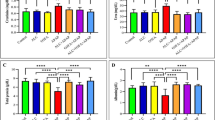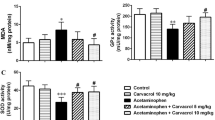Abstract
Acetaminophen (APAP) is one of the most widely consumed drugs in the world. Studies have shown renal and hepatic damage as the direct result of high oxidative stress induced by APAP. Since the cardiovascular system is sensitive to oxidative stress and literature describes increased cardiovascular dysfunction in APAP consumers, this work aimed to evaluate harmful effects of APAP on the vascular system. Rats were exposed to APAP (400 mg/kg/day in drinking water) for 14 days. Plasma and aortas were collected and stored in − 80 °C and a selection of arteries was prepared for isometric tension recordings, morphological, immunohistochemical and protein expression analysis. The APAP-treated group presented increased transaminases (ALT/AST) and malondialdehyde levels in the plasma compared to controls. Lipid peroxidation, glutathione reductase and superoxide dismutase levels were increased in the plasma and arteries of the APAP group. Nevertheless, glutathione level was reduced as compared to control group. The vasodilation response to acetylcholine and sodium nitroprusside (0.1 nM to 10 µM) was also impaired after APAP treatment; however, the vascular relaxation was restored after treatment with vitamin C (100 µM). Arteries from the APAP group presented reduced wall thickness, collagen deposition, elastic fibers and increased immunoreactivity to nitrotyrosine. eNOS and sGC protein expression remained unchanged and were at similar levels as controls. These findings showed higher oxidative stress and impaired vasodilation in rats exposed to APAP. Furthermore, arteries presented reduced cell layers, collagen, elastin deposition and significantly increased immunoreactivity to nitrotyrosine after APAP treatment.






Similar content being viewed by others
References
Bachmann M, Pfeilschifter J, Mühl H (2018) A prominent role of interleukin-18 in acetaminophen-induced liver injury advocates its blockage for therapy of hepatic necroinflammation. Front Immunol 9:161
Bertolini A, Ferrari A, Ottani A, Guerzoni S, Tacchi R, Leone S (2006) Paracetamol: new vistas of an old drug. CNS Drug Rev 12:250–275
Blieden M, Paramore LC, Shah DD, Ben-Joseph R (2014) A perspective on the epidemiology of acetaminophen exposure and toxicity in the United States. Expert Rev Clin Pharmacol 3:341–348
Chan AT, Manson JE, Albert CM (2006) Nonsteroidal antiinflammatory drugs, acetaminophen, and the risk of cardiovascular events. Circulation 113:1578–1587
Cigremis Y, Turel H, Adiguzel K et al (2009) The effects of acute acetaminophen toxicity on hepatic mRNA expression of SOD, CAT, GSH-Px, and levels of peroxynitrite, nitric oxide, reduced glutathione, and malondialdehyde in rabbit. Mol Cell Biochem 323(1–2):31–38
Curhan GC, Willett WC, Rosner B, Stampfer MJ (2002) Frequency of analgesic use and risk of hypertension in younger women. Arch Intern Med 162(19):2204–2208
Ding Y, Li Q, Xu Y et al (2016) Attenuating oxidative stress by paeonol protected against acetaminophen-induced hepatotoxicity in mice. PLoS One 11(5):e0154375
Eisenach JH, Gullixson LR, Allen AR, Kost SL, Nicholson WT (2014) Cyclo-oxygenase-2 inhibition and endothelium-dependent vasodilation in younger vs. older healthy adults. Br J Clin Pharmacol 78(4):815–823
Eiserich JP, Hristova M, Cross CE et al (1998) Formation of nitric oxide-derived inflammatory oxidants by myeloperoxidase in neutrophils. Nature 391:393–397
Forman JP, Rimm EB, Curhan GC (2007) Frequency of analgesic use and risk of hypertension among men. Arch Intern Med 167(4):394–399
Fulton RL, Walters MR, Morton R (2015) Acetaminophen use and risk of myocardial infarction and stroke in a hypertensive cohort. Hypertension 65:1008–1014
Glasser SP, Khodneva Y (2015) Should acetaminophen be added to the list of anti-inflammatory agents that are associated with cardiovascular events? Hypertension 65(5):991–992
Gross GJ, Moore J (2004) Effect of COX-1/COX-2 inhibition versus selective COX-2 inhibition on coronary vasodilator responses to arachidonic acid and acetylcholine. Pharmacology 71:135–142
Hale SL, Kloner RA (2005) Acetaminophen and myocardial stunning after transient ischemia in rabbit hearts. J Cardiovasc Pharmacol Ther 10(2):121–129
Isaeva EV, Shkryl VM, Shirokova N (2005) Mitochondrial redox state and Ca2+ sparks in permeabilized mammalian skeletal muscle. J Physiol 565:855–872
James LP, Mayeux PR, Hinson JA (2003) Acetaminophen-induced hepatotoxicity. Drug Metab Dispos 31(12):1499–1506
Jordão JBR, Porto HKP, Lopes FM (2017) Protective effects of ellagic acid on cardiovascular injuries caused by hypertension in rats. Planta Medica 83(10):830–836
Klein T, Eltze M, Grebe T, Hatzelmann A, Kömhoff M (2007) Celecoxib dilates guinea-pig coronaries and rat aortic rings and amplifies NO/cGMP signaling by PDE5 inhibition. Cardiovasc Res 75:390–397
Knight TR, Kurtz A, Bajt ML et al (2001) Vascular and hepatocellular peroxynitrite formation during acetaminophen toxicity: role of mitochondrial oxidant stress. Toxicol Sci 62:212–220
Lassegue B, Griendling KK (2004) Reactive oxygen species in hypertension. An update. Am J Hypertens 17(9):852–860
Lau YS, Tian XY, Huang Y et al (2013) Boldine protects endothelial function in hyperglycemia-induced oxidative stress through an antioxidant mechanism. Biochem Pharmacol 85:367–375
Lee WM (2003) Drug-induced hepatotoxicity. N Engl J Med 349:474–485
Li H, Cao Z, Moore DR et al (2012) Microbicidal activity of vascular peroxidase 1 in human plasma via generation of hypochlorous acid. Infect Immun 80(7):2528–2537
Majhi CR, Khan S, Leo MDM et al (2011) Effects of acetaminophen on reactive oxygen species and nitric oxide redox signaling in kidney of arsenic-exposed rats. Food Chem Toxicol 49:974–982
Masutani H (2001) Oxidative stress and redox imbalance in acetaminophen toxicity. Pharmacogen J 1(3):165–166
O’donnell VB, Fremann BA (2001) Interactions between nitric oxide and lipid oxidation pathways: implications for vascular disease. Circ Res 88:12–21
Ozturk S, Yetkin E, Waltenberger J (2018) Molecular and cellular insights into the pathogenesis of coronary artery ectasia. Cardiovasc Pathol 35:37–47
Radovits T, Rawa Arif A, Bomicke Timo et al (2013) Vascular dysfunction induced by hypochlorite is improved by the selective phosphodiesterase-5-inhibitor vardenafil. Eur J Pharmacol 710:110–119
Reagan-Shaw S, Nihal M, Ahmad N (2008) Dose translation from animal to human studies revisited. FASEB J 22:659–661
Reitman S, Frankel S (1957) A colorimetric method for the determination of serum glutamic oxalacetic and glutamic pyruvic transaminases. Am J Clin Pathol 28:56–63
Rice KM, Meduru S, Kakarla SK et al (2012) Chronic paracetamol treatment influences indices of reactive oxygen species accumulation in the aging fischer 344 X Brown Norway rat aorta. Ann Clin Lab Sci 42:152–161
Roberts E, Nunes VD, Buckner S (2016) Paracetamol: not as safe as we thought? A systematic literature review of observational studies. Ann Rheum Dis 75:552–559. https://doi.org/10.1136/annrheumdis-2014-206914
Rodrigues GJ, Lunardi CN, Lima RG, Santos CX, Laurindo FR, da Silva RS, Bendhack LM (2008) Vitamin C improves the effect of a new nitric oxide donor on the vascular smooth muscle from renal hypertensive rats. Nitric Oxide 18:176–183
Rubbo H, Radi R, Trujillo M et al (1994) Nitric oxide regulation of superoxide and peroxynitrite-dependent lipid-peroxidation. Formation of novel nitrogen-containing oxidized lipid derivatives. J Biol Chem 269:26066–26075
Saito C, Lemasters JJ, Jaeschke H (2010) c-Jun N-terminal kinase modulates oxidant stress and peroxynitrite formation independent of inducible nitric oxide synthase in acetaminophen hepatotoxicity. Toxicol Appl Pharmacol 246(1–2):8–17
Souza CG, Lobo Daniela Medeiros, de Andrade DLM, Jordão JBRJ (2017) Radical scavenger capacity of jabuticaba fruit (Myrciaria cauliflora) and its biological effects in hypertensive rats. Oxid Med Cell Longev 2017:2383157
Sudano I, Flammer AJ, Périat D et al (2010) Acetaminophen increases blood pressure in patients with coronary artery disease. Circulation 122:1789–1796
Taye A, Saad AH, Kumar AH, Morawietz H (2010) Effect of apocynin on NADPH oxidase-mediated oxidative stress-LOX-1-eNOS pathway in human endothelial cells exposed to high glucose. Eur J Pharmacol 627:42–48
Tittarelli R, Pellegrini M, Scarpellini MG, Marinelli E, Bruti V, di Luca NM, Busardo FP, Zaami S (2017) Hepatotoxicity of paracetamol and related fatalities. Eur Rev Med Pharmacol Sci 21:95–101
Turtle EJ, Dear JW, Webb DJ (2013) A systematic review of the effect of paracetamol on blood pressure in hypertensive and non-hypertensive subjects. Br J Clin Pharmacol 6:1396–1405
van Varik BJ, Rennenberg RJMW, Reutelingsperger CP et al (2012) Mechanisms of arterial remodeling: lessons from genetic diseases. Front Genet 3:290
Varadharaj S, Kelly OJ, Khayat RN, Kumar PS, Ahmed N, Zweier JL (2017) Role of dietary antioxidants in the preservation of vascular function and the modulation of health and disease. Front Cardiovasc Med 4:1–11
Verma S, Raj SR, Shewchuk L, Mather KJ, Anderson TJ (2001) Cyclooxygenase-2 blockade does not impair endothelial vasodilator function in healthy volunteers: randomized evaluation of rofecoxib versus naproxen on endothelium-dependent vasodilatation. Circulation 104(24):2879–2882
Vogel C, Silva GM, Marcotte EM (2011) Protein expression regulation under oxidative stress. Mol Cell Proteom 10(12):M111.009217
Watkins PB, Kaplowitz N, Slattery JT, Colonese CR, Colucci SV, Stewart PW, Harris SC (2006) Aminotransferase elevations in healthy adults receiving 4 g of acetaminophen daily: a randomized controlled trial. JAMA 296(1):87–93
White WB (2007) Cardiovascular effects of the cyclooxygenase inhibitors. Hypertension 49:408–418
Yan M, Huo Y, Yin S, Hu H (2018) Mechanisms of acetaminophen-induced liver injury and its implications for therapeutic interventions. Redox Biol 17:274–283
Acknowledgements
Aline C. Batista, Lusiane M. Bendhack, Marize C. Valadares, Matheus L. Rocha are researchers fellow of Conselho Nacional de Desenvolvimento Cientifico e Tecnologico (CNPq, Brazil).
Author information
Authors and Affiliations
Corresponding author
Ethics declarations
Conflict of interest
The authors declare no conflict of interest, financial or otherwise.
Ethical approval
All procedures performed in studies involving animals were in accordance with the ethical standards of the institution or practice at which the studies were conducted (protocol number 083/16).
Additional information
Publisher's Note
Springer Nature remains neutral with regard to jurisdictional claims in published maps and institutional affiliations.
Rights and permissions
About this article
Cite this article
Porto, H.K.P., Grando, M.D., Ramalho, L.N.Z. et al. Exposure to acetaminophen impairs vasodilation, increases oxidative stress and changes arterial morphology of rats. Arch Toxicol 93, 1955–1964 (2019). https://doi.org/10.1007/s00204-019-02463-0
Received:
Accepted:
Published:
Issue Date:
DOI: https://doi.org/10.1007/s00204-019-02463-0




